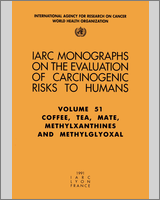From: Caffeine

Coffee, Tea, Mate, Methylxanthines and Methylglyoxal.
IARC Monographs on the Evaluation of Carcinogenic Risks to Humans, No. 51.
IARC Working Group on the Evaluation of Carcinogenic Risks to Humans.
Lyon (FR): International Agency for Research on Cancer; 1991.
©International Agency for Research on Cancer, 1991.
NCBI Bookshelf. A service of the National Library of Medicine, National Institutes of Health.